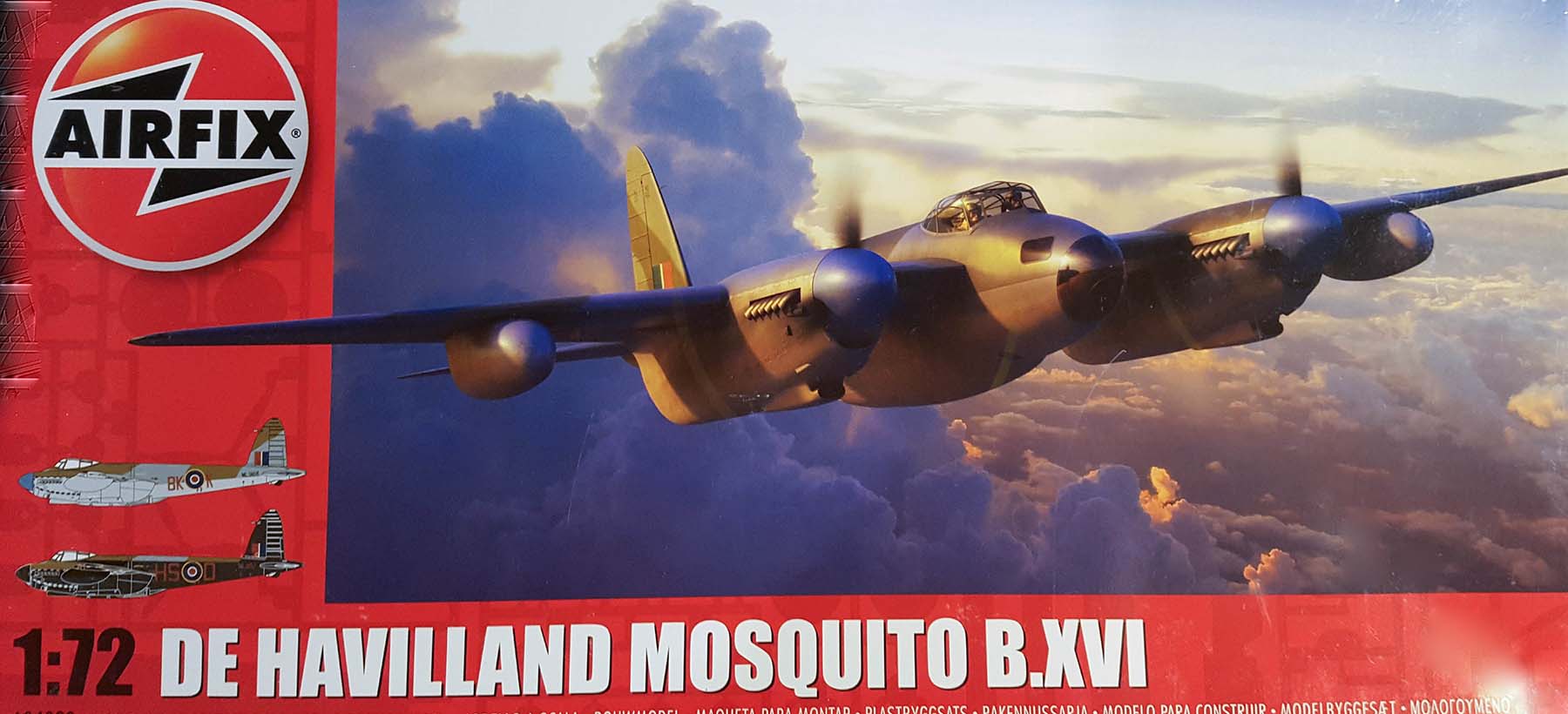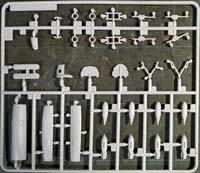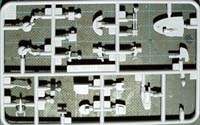
Airfix 1/72 Mosquito B.XVI Kit First Look
By Michael J. Gething
| Date of Review | October 2021 | Manufacturer | Airfix |
|---|---|---|---|
| Subject | Mosquito B.XVI | Scale | 1/72 |
| Kit Number | A04023 | Primary Media | Styrene |
| Pros | Excellent detail | Cons | Some delicate parts |
| Skill Level | Moderate | MSRP (GBP) | £19.99 |
First Look
 |
 |
 |
 |
 |
 |
 |
 |
The de Havilland DH.98 Mosquito was a true multi-role combat aircraft long before the MRCA (as Panavia’s Tornado was initially known) was ever conceived. Its official genesis was as an unarmed photo-reconnaissance platform and Air Ministry Specification B.1/40 was drawn up on this premise, while future fighter and bomber variants were to be explored. It was what today is called a private venture project and was built principally of a laminated balsa/birch plywood (non-strategic materials at the time), and later was dubbed the “Wooden Wonder”.
A prototype (W4050) flown on 25 November 1940 and, by March 1941, a contract was in place for 50 bomber-reconnaissance versions and the rest, if you will forgive the clichee, “is history” – a full history easily accessible online or in several books. (I particularly recommend Mosquito by C. Martin Sharp and Michael J. F. Bowyer.) Suffice it to say that fighter and bomber versions were indeed developed, and the Mosquito proved a total success in service in all three major roles, undertaking many other second-line duties later in its career, including target-towing. When the last Mosquito (VX196 – an NF.38 for Yugoslavia) was completed in November 1950, 7,781 aircraft had been produced.
The subject of this kit, the B.XVI (first flown on 1 January 1944), was a development of the B.IX fitted with a pressurised cabin and powered by a pair of Rolls-Royce Merlin 72/73 or 76/77 two-stage engines. It was capable of maximum speeds between 329 and 419 mph (depending on weight and height) at operational altitudes between 31,000ft and 39,000ft (depending on weight). It could be configured to carry four or six 500lb bombs or a single 4,000lb ‘blockbuster’ bomb.
The B.XVI is the fourth iteration of the Mosquito from Airfix in 1/72 scale: the first (Airfix ref: 1402) being an FB Mk.VI in 1957, followed by the Mk.II/VI/XVIII (A03019) in 1972 and, in 1995, the NF.XIX/J.30 (A03062). The latter was essentially the A03019 tool with an extra sprue providing a radar nose and four-blade propellers, plus a revised instruction sheet and decals. The new-tool B.XVI is the first bomber variant from the company, featuring a detailed bomb bay, with four bombs, and provision to build with bomb doors open, as well as the two-stage Merlin engines.
The kit itself comprises six sprues of light grey plastic (labelled as frames, BUT there is no frame D) plus one transparency spruce (offering two canopy options, only one of which is applicable to this mark). The lack of a frame D and a second canopy option (with an astrodome over the navigator position) are indicative of a future re-issue as a later variant. As is now the norm, the crisp, engraved panel lines reflect the detail of the exterior and internal details cover not only the cockpit area but the interior of the bomb bay and undercarriage bays. Many of these parts are small and delicate, so care should be taken when detaching them from the sprues. Thought has also been given to those modellers using an air brush for painting, as masking blanks are provided for the bomb bay and undercarriage bays to protect internal detail. Compared with building the original Mosquito kit, when as a 13-year-old, it could be built in an afternoon and painted the next day, today’s model will take a lot more time, even if one chooses not to paint the interior details!
Stages 1 to 11 cover assembly of the cockpit/centre section, including wing spars and main fuel tanks in the bomb bay. There is much internal detail to be painted here. Stages 12 to 17 cover assembly of the fuselage, while stages 18 to 21 cover the empennage. Stages 22 to 31 cover assembly of the two main undercarriage units, using the upper wing location holes as a jig to ensure accurate alignment. Stages 32 to 34 cover the port wing (drilling the locating holes for the underwing fuel tanks at 32), followed by the port engine in stages 35 to 50, with stage 47 requiring a decision on whether or not to have the undercarriage up or down. If the former, one part covers the closed doors. Stages 51 to 54 cover installation of the port undercarriage unit. Stages 54 and 56 cover the port propeller installation.
Stages 57 to 92 mirror assembly of the starboard wing, engine, and undercarriage. Stage 93 offers the closed bomb bay door option; stages 94 to 103 covers the bomb bay details, including the four bombs. Again, some pre-painting of internal detail is required, including the bombs which require some decal stencilling. Stages 104 to 106 adds the underwing tanks (if fitted), while 107 has the pilot figure installed (although no navigator figure is supplied). The cockpit canopy is a three-piece assembly at stages 108 and 109. (Do NOT use parts H5, H14 and H15, as these are for a later mark of Mosquito, as mentioned above.) The nose transparencies are fixed at stage 110. The tail wheel, down or retracted, is covered by stage 111 with stage 112 locating the fin-mounted pitot tube.
Two decal options allow the B.XVI model to be completed as either an aircraft of 571 Sqn from No.8 (Pathfinder) Group flying from RAF Oakington in September 1944 (in a dark green/ocean grey/medium sea grey scheme) or a 109 Sqn aircraft from RAF Wyton in 1944 (in a dark green/ocean grey/matt black scheme). As is now usual, the various stencil markings are provided, although the modeller will require to dig deep into his well of patience for their application.
In summary, this is a well-produced kit which will build into a delightful model of the bomber variant of the Mosquito but it is not for the novice.







